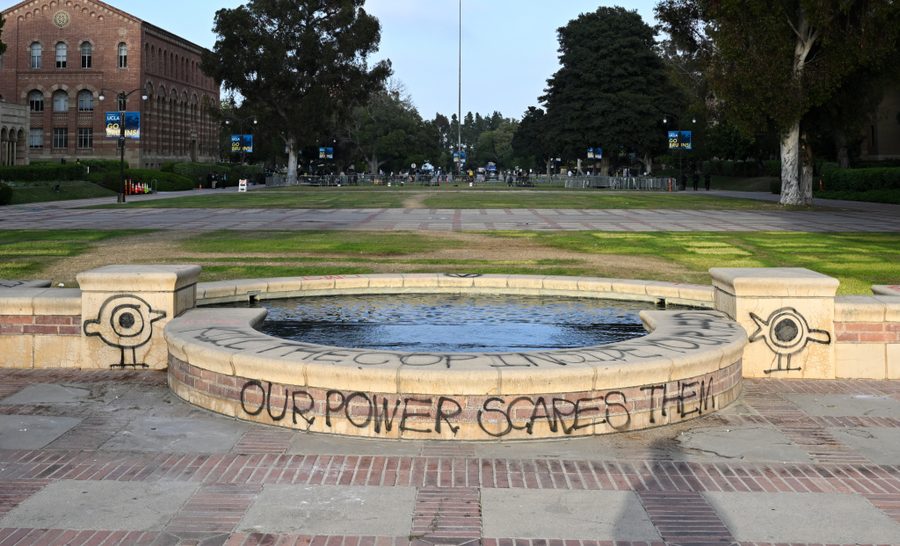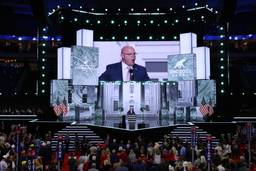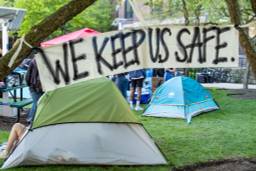Union Power Can Change Campus Protests Forever
A strike authorization vote at the University of California over repression of Gaza protesters hints at labor’s political potential.
Hamilton Nolan

Strikes are different from protests. Though protesters frequently say that they are making “demands,” it is more accurate to say they are making requests. Protests rely on persuasion. Their persuasion may be gentle, or it may be aggressive. It may rely on moral shaming to get its point across, or it may rely on the elevation of awareness, or it may rely on the pure intimidation of numbers. But protests, for all of their righteous fury and necessity, lack the legal ability to shut things down until change is achieved.
Strikers, on the other hand, can truly make demands. Their proposition is simple: No work will get done until a change is made. Obstinate institutions can resist protests, and call out the police to disperse them, but that resistance is less effective against strikes, for the simple reason that the strikers are also the workers who make the very same institutions run. This intrinsic power of strikes is the reason why they are so strictly regulated, why entire categories of strikes have been deemed illegal ever since the Taft-Hartley Act passed in 1947. It is also why it is always wise, when we challenge power, to ask ourselves: Could this protest also be a strike?
The wave of protests against the war on Gaza that has swept America’s college campuses in recent weeks is an inspiring example of young people refusing to acquiesce to an atrocity that many of their elders have already rationalized away. The protests have succeeded in forcing institutions of all types to take a side on an issue that many would have preferred to pretend does not involve them. Many college presidents, torn between the demands of wealthy conservative donors and the irksome desire to live up to their own hollow declarations of progressive values, have exposed themselves as both pathetic and hysterical. Riot police have proven to be a more favored method of control than reasoned discussion. The images of militarized cops descending on kids in tents who are asking to stop a genocide have made the protesters’ point as effectively as anything they could have hoped for.

Universities are hoping to wipe out the budding movement with a combination of police and time. They are, I’m quite sure, hoping that the protesters do not start thinking deeply about the fact that colleges and universities have been the site of the largest union organizing campaigns in this country for the past several years. Higher education is in the midst of the most sweeping union wave of any industry in America. Unions of tenured professors, adjunct professors, grad student workers, and other campus employees — organized in the tens of thousands — fill the same campuses that the protest encampments do. Many of the people who have joined the encampments, and been arrested therein, are union members. The universe has teed up a beautiful opportunity to demonstrate the way that organized labor power can be used to accomplish broader political goals.
This week, the eyes of the union world are focused on the United Auto Workers vote at a Mercedes factory in Alabama, where the union is prepared to secure a landmark win in the hostile South. But there is another UAW vote this week that is exciting for its own reasons: the strike authorization vote of UAW Local 4811, which represents about 48,000 academic workers in the University of California system. That vote will be the most substantial act so far of a union formally inserting itself into the heart of the Gaza protests, in the way that schools fear the most.
America’s employer-friendly labor laws strictly box in where and when most unions are allowed to legally strike. For the most part, union contracts include “no strike” clauses that restrict striking for the life of the contracts. An exception, though, is that employees can strike to protest unfair labor practices — including things an employer does that put the health and safety of union members at risk. Can you think of anything that universities have done recently to put the health and safety of their campus employees — such as professors and grad student workers — at risk? Ah, yes: Calling in the damn riot police on peaceful encampments! The very same high-handed exercise of violent power that schools have used to try to silence the protests have opened the door to a strike — an even more formidable action than the encampments themselves.
Tanzil Chowdhury, a UAW 4811 executive board member and the union’s statewide Academic Student Employee chair, told In These Times that the seeds for the strike vote were planted when the protest encampments at UCLA were met first with violent counterprotests, and then with an aggressive attack by police wielding rubber bullets and tear gas. Present at that protest were some members of the union’s executive board. “It was at that point that it became clear that the university was committing major overreach,” Chowdhury said. Other UC campuses experienced similar harsh tactics, including at UC San Diego, where dozens of student protesters were arrested and found their housing and health insurance coverage at risk.
The union’s leaders recognized that these actions from school administrators were not just objectionable — they were contract violations. Specifically, the union says that the schools’ police interventions, and subsequent retaliation against protesting union members, violate those members’ legally protected rights to engage in concerted activity to demand change in their own working conditions. They also say that the schools’ reactionary changes to campus speech policies, without giving the union the chance to bargain over them, are unfair labor practices as well. “These ULPs cut to the core of what it means to be a union,” Chowdhury said. “If workers don’t feel safe in their workplace, if they feel the campus can unilaterally change all of its policies… can we really even have a union that can stand up for anything we care about?”
Hence the strike authorization vote. If successful, it would give the union’s leadership the ability to call strikes where and when they deem necessary — and would therefore force university leaders to think much more carefully about their future repressive tactics. It is easier for a panicky college president to call in the cops when they don’t have to worry about the possibility that they could prompt a strike that would shut down all of the school’s academic operations. UAW 4811 is attempting to alter the entire balance of power surrounding the campus protests, in a way that the universities will not be able to ignore.
Notably, Chowdhury said that the academic union would model any strikes on the “Stand Up” model that the UAW used with great success against the Big Three auto companies last year. Rather than calling on everyone to walk out at once, the union could choose to call specific campuses out as needed, with no prior warning. The tactic gives the union flexibility, lessens the burden on striking members, and puts the onus on employers to police their own conduct. For anyone who has ever asked, “Why does the auto workers union have a bunch of grad student members?,” here is an answer. We are on the cusp of seeing the tactics of an auto strike spread to a statewide university system in real time.
This is how the labor movement is supposed to work. Workers use their collective labor power to protect their ability to freely exercise their political rights in the workplace. Wisdom earned in one industry spreads to others, as workers recognize that they have more in common than they thought. The willingness of a strong union to use its latent strike power inspires more of its members to explore how they can do the same thing. If UAW 4811’s strike authorization vote passes, it will instantly become a proof of concept for hundreds of thousands of other union members on protest-wracked campuses from coast to coast. It will place the union right where it should be: Not standing idly apart from broad political fights, but right at their center.
From auto workers, to campus workers, to Gaza protesters. This is how it spreads. This is how unions grow into the full potential of their own power. This is how the labor movement becomes one with social movements. This is how the unthinking willingness to use riot cops to beat down political disagreements can get put to an end.
Hamilton Nolan is a labor writer for In These Times. He has spent the past decade writing about labor and politics for Gawker, Splinter, The Guardian, and elsewhere. More of his work is on Substack.








